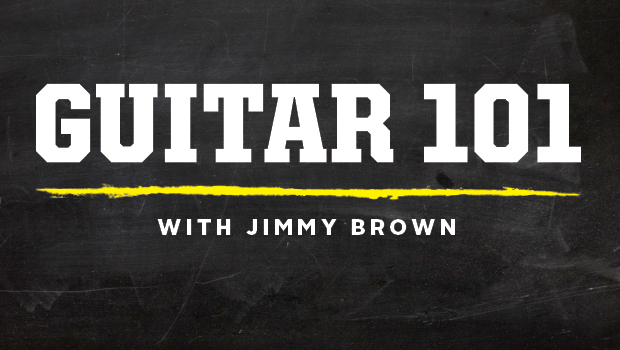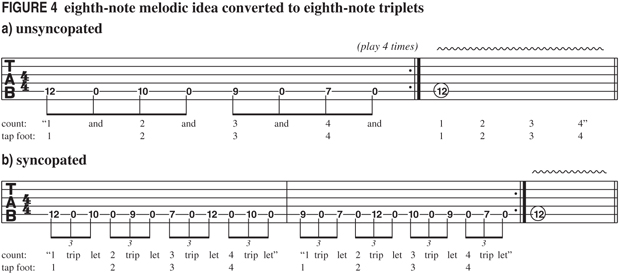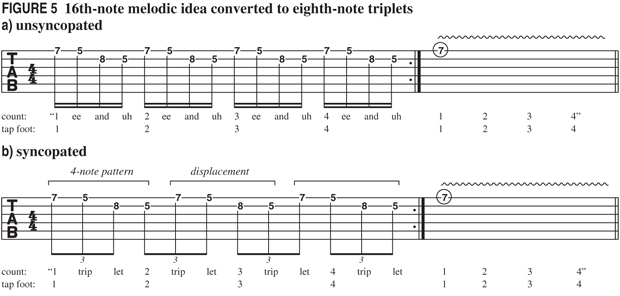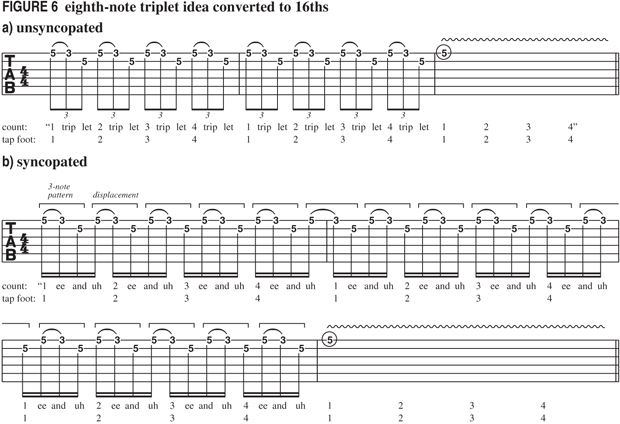Guitar 101 - Mastering Rhythm & Syncopation, Part 3: Triplets and Hemiola

In part 2 I introduced you to 16th notes and demonstrated how to create a variety of funky syncopations by using rests and dotted rhythms, as well as ties. I hope you've been using every transcription and lesson example you come across to practice your rhythm reading and counting skills because doing this will definitely help improve and sharpen your rhythmic sense, no matter what level you're at as a player or what style(s) you're into. Being able to count, read and, most importantly, feel the complex rhythms of today's music is something that requires a bit of practice to become proficient at, so make a point of reading and counting rhythms on a regular basis (15 minutes a day is good!).
As promised at the end of our last lesson, we're now going to learn how to count, read and play triplets. As you recall, a quarter-note beat can be evenly subdivided into two eighth notes ("one and") or four 16th notes ("one ee and uh"). You can also split it equally into three eighth-note triplets, as the riff in FIGURE 1 demonstrates. Notice that while eighth-note triplets are similar in appearance to eighth notes (duplets), in that both subdivisions are connected with a single beam, they're grouped in threes, with a numeral "3" centered below the beam.

Counting "one trip let, two trip let, three trip let, four trip let, one trip let, two trip let, three trip let, four trip let," etc. enables us to keep track of every triplet and beat in a measure of 4/4 while maintaining a steady pulse. (Some musicians and teachers prefer to count eighth-note triplets as "one and uh, two and uh, three and uh, four and uh," which is admittedly less of a tongue-twister at fast tempos, but I've found that students who do this run the risk of mistakenly confusing the "and" and "uh" counts with those used for eighth and 16th notes, which fall on different parts of the beat.)
Because we're now subdividing the beat into three equally-spaced notes, each individual eighth-note triplet has a slightly shorter duration than an eighth-note duplet played at the same tempo. Thus, eighth-note triplets are "faster" than regular eighth notes.
Due to the odd subdivision of the beat (three equal parts instead of two or four), eighth-note triplets "go against the grain" of eighth notes and 16th notes and require a different counting pattern. FIGURE 2 is a riff that uses eighth notes, eighth-note triplets and 16ths, requiring you to change counting patterns as you play. As I've previously advised you to do when sight-reading any piece of sheet music for the first time, first clap the rhythms of the notes (or tap them on your knee) before playing the notes on your instrument to help you focus on interpreting the rhythms correctly. And, as always, be sure to tap your foot in a steady quarter-note pulse. This will insure that you don't speed up or slow down the tempo when "shifting gears" from duplets to triplets to "quadruplets" (as 16th notes are also known).

Ties and rests can be used with eighth-note triplets to create a variety of interesting triplet syncopations, as demonstrated in FIGURE 3. Notice in bar 2 of this example that a quarter note may be substituted for a pair of tied eighth-note triplets within a single beat (as used in bar 1 for the sake of comparison). This is considered more economical notation, as there are fewer items to read. For this same reason, a quarter rest is preferred over two consecutive eighth-note-triplet rests that fall within the same beat (compare bar 3 to bar 4). A pair of brackets with "3" centered between them is used in conjunction with (or instead of) a beam in these types of "broken" eighth-note triplet figures. The bracket indicates that the quarter note or quarter rest represents two thirds of the triplet figure and not an entire beat, as would normally be the case.

FIGURES 4 and 5 are examples of how you can take a simple, repeating melodic pattern of eighth notes or 16ths and transform it into an exciting and tricky-sounding lick by playing it in an eighth-note triplet rhythm. FIGURE 4a is a single-string pedal point lick played in even eighth notes. While the note pattern is fairly interesting, the rhythm is rather bland, as it is unsyncopated-no upbeats are emphasized. Notice how much cooler and intense this same note pattern sounds when played as eighth-note triplets (see FIGURE 4b). The accented fretted notes create syncopation and convey what is known as a quarter-note triplet rhythm.
All the latest guitar news, interviews, lessons, reviews, deals and more, direct to your inbox!

FIGURE 5a is a repeating four-note descending lick played in even 16th notes. Notice how it begins squarely on the beat each time it's repeated. This same note pattern becomes much more interesting when played as eighth-note triplets, as demonstrated in FIGURE 5b. Because the pattern is still four notes, it's rhythmically displaced each time it's repeated, shifting ahead one eighth-note triplet with each repetition. This melodic device, known as hemiola, produces a compelling syncopation effect and generates rhythmic tension. It also plays tricks on the listener's ear by creating the aural illusion of "phony 16ths" played at a slower tempo.

It sounds equally cool to do the opposite thing and take a repeating three-note pattern, like the triplet lick shown in FIGURE 6a, and change the rhythm to 16ths, as demonstrated in FIGURE 6b. In this example, the lick begins one 16th note earlier with each displacement. Like the "fours on threes" hemiola lick in FIGURE 5b, FIGURE 6b's "threes on fours" pattern suggests a superimposed rhythm, in this case "phony triplets" at a slower tempo.

Be sure to practice FIGURES 5b and 6b slowly at first while tapping your foot until you feel you can play them cleanly and consistently without fudging any notes or losing track of the beat. Then work on playing them faster.
Over the past 30 years, Jimmy Brown has built a reputation as one of the world's finest music educators, through his work as a transcriber and Senior Music Editor for Guitar World magazine and Lessons Editor for its sister publication, Guitar Player. In addition to these roles, Jimmy is also a busy working musician, performing regularly in the greater New York City area. Jimmy earned a Bachelor of Music degree in Jazz Studies and Performance and Music Management from William Paterson University in 1989. He is also an experienced private guitar teacher and an accomplished writer.

